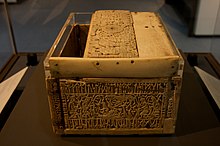
Back Runenkästchen von Auzon ALS صندوق فرانكس Arabic Куфэрак Фрэнкса Byelorussian Franks Casket Danish Runenkästchen von Auzon German Cofre de Auzon Spanish Coffret d'Auzon French Cofanetto Franks Italian Franks Casket Dutch Franks Casket NN

The Franks Casket (or the Auzon Casket) is a small Anglo-Saxon whale's bone (not "whalebone" in the sense of baleen) chest from the early 8th century, now in the British Museum. The casket is densely decorated with knife-cut narrative scenes in flat two-dimensional low-relief and with inscriptions mostly in Anglo-Saxon runes. Generally thought to be of Northumbrian origin,[1] it is of unique importance for the insight it gives into early Anglo-Saxon art and culture. Both identifying the images and interpreting the runic inscriptions has generated a considerable amount of scholarship.[2]

The imagery is very diverse in its subject matter and derivations, and includes a single Christian image, the Adoration of the Magi, along with images derived from Roman history (Emperor Titus) and Roman mythology (Romulus and Remus), as well as a depiction of at least one legend indigenous to the Germanic peoples: that of Weyland the Smith. It has also been suggested that there may be an episode from the Sigurd legend, an otherwise lost episode from the life of Weyland's brother Egil, a Homeric legend involving Achilles, and perhaps even an allusion to the legendary founding of England by Hengist and Horsa.
The inscriptions "display a deliberate linguistic and alphabetic virtuosity; though they are mostly written in Old English and in runes, they shift into Latin and the Roman alphabet; then back into runes while still writing Latin".[3] Some are written upside down or back to front.[4] It is named after a former owner, Sir Augustus Wollaston Franks, who gave it to the British Museum.
- ^ The first considerable publication, by George Stephens, Old-Northern Runic Monuments of Scandinavia and England (1866–1901) I-II:470-76, 921-23, III:200-04, IV:40-44, placed it in Northumbria and dated it to the 8th century. Although A. S. Napier (1901) concurs with an early 8th-century Northumbrian origin, Mercia, and a 7th-century date, have also been proposed .[citation needed] The British Museum website (see external links) says Northumbria and "first half of the 8th century AD", as does Webster (2012a:92), "early part of the eighth century".
- ^ Vandersall summarises the previous scholarship as at 1972 in setting the casket into an art-historical, rather than linguistic context. Mrs Leslie Webster, former Keeper at the British Museum and the leading expert, has published a new short book on the casket (Webster 2012b).
- ^ Webster (2000).
- ^ Parsons (1999, 98-100) has an important discussion on the runes used in the Franks Casket.